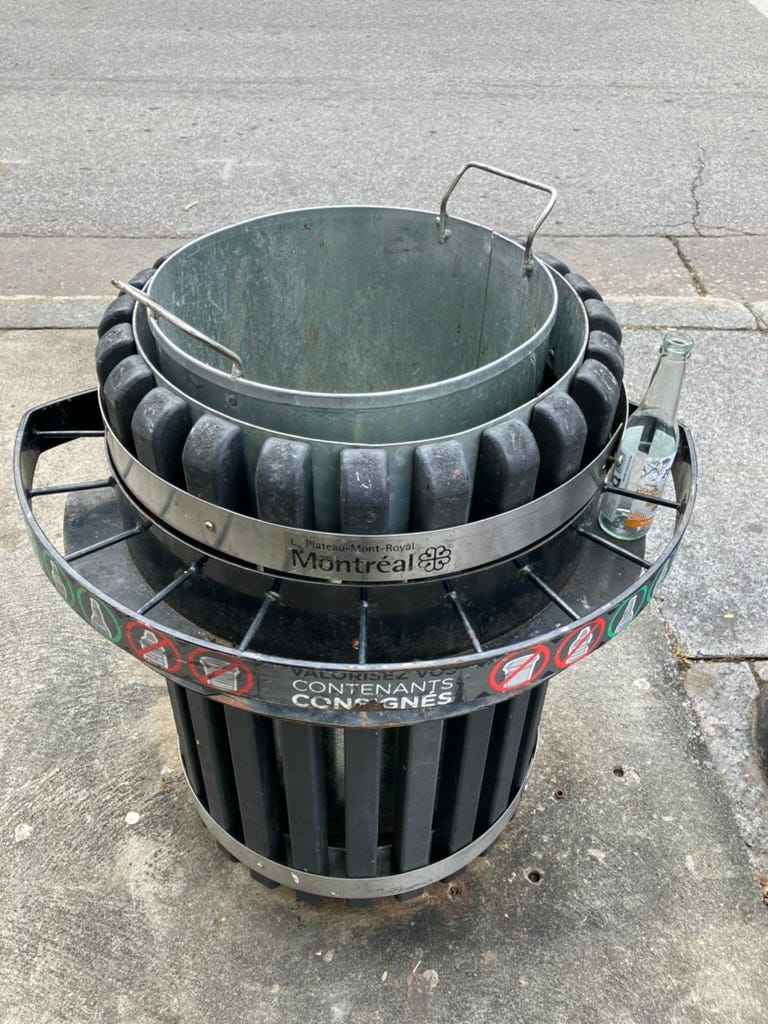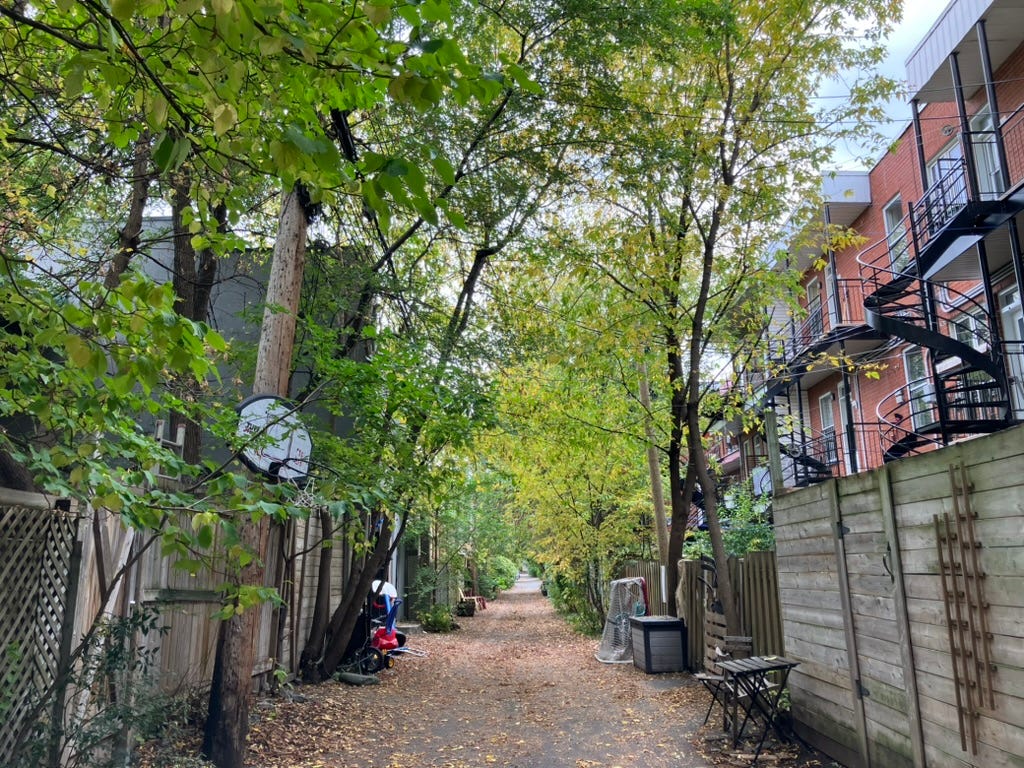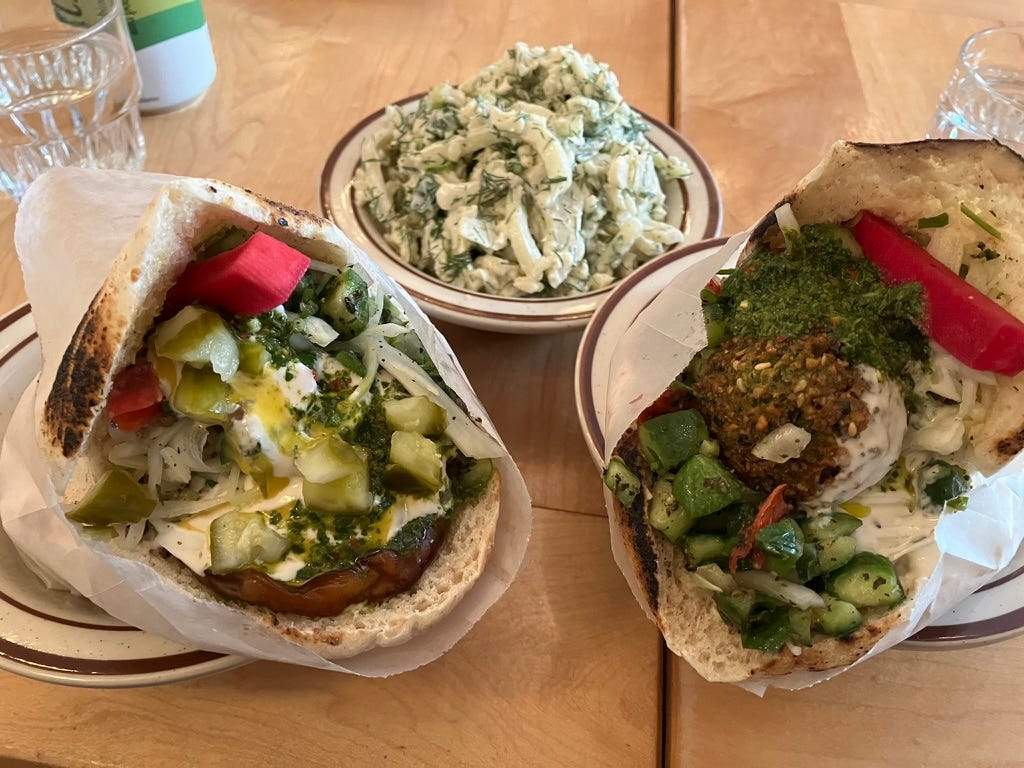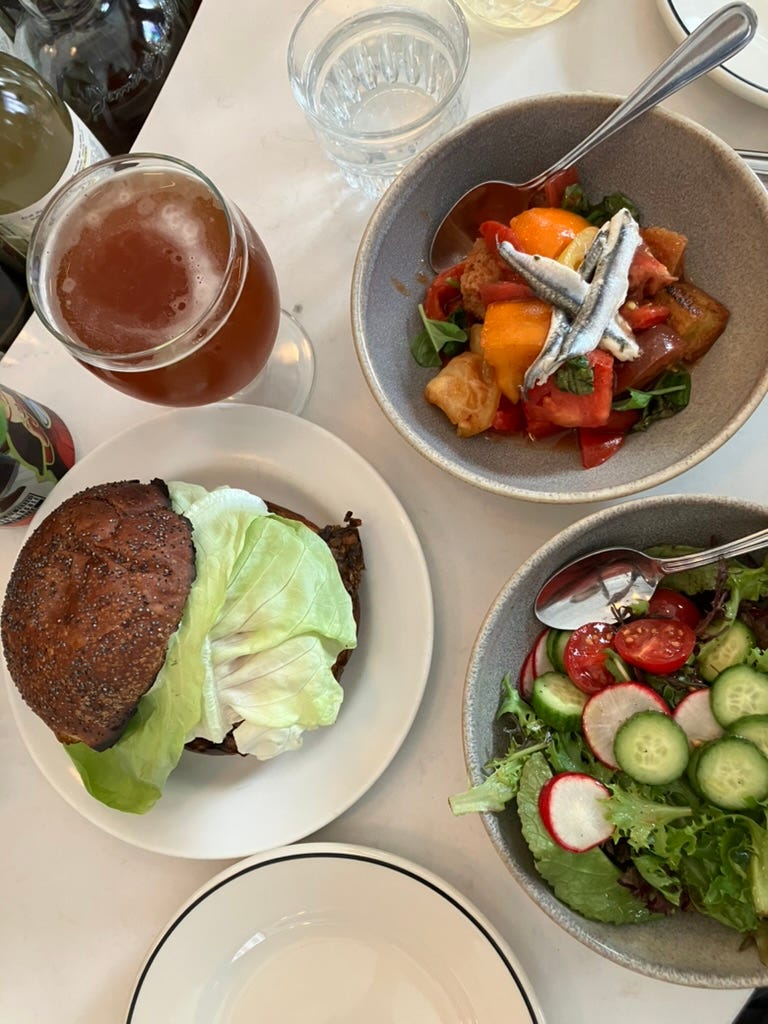Hullo to readers old and new! I have two popups this weekend:
Kuih muih at Elmendorf Baking this Saturday, April 6th 1-3pm. There will be dodol. There will be pre-orders. I’ll post a link when one goes live.
Hokkien mee and other bits and bobs at Backbar this Sunday, April 7th, 5pm-late. I’ll list the bits and bobs later this week.
Come say hi!
I was in Montreal 6 months ago (for this insanity), but so much of the city remains stuck in my head. Like this recycling rail, a Mad Max after-market mod found on many trash cans around the city. It acknowledges that drinking in public is allowed and commonplace, and that the city is sufficiently unequal that many people live as urban gleaners; easing the gleaners’ work, and reducing spillage in recycling bins.
Or these rings, which mean parking meters mark parking spots for bikes as well. Most meters in the city wear one.
Or the alleyways between rows of duplexes, unassuming pieces of public space placed to suggest communal use. I’ve met people like this – quiet, inviting, deliberately interstitial.
It’s pure unlicensed poetry to think a city has an anima, that its politics and values also manifest in its establishments, but every meal we had in Montreal was full of gestures like this, brilliant, humane, unnecessary. When did joy start to feel like a luxury?
Look at this lunch, at Sumac. Sandwiches for the sandwich hall of fame. Expert engineering – massive but easily manageable, no spills to chase, everything perfectly distributed inside the pitas. The cauliflower and fennel salad was a textural marvel – thick shards of fennel picking up cauliflower pieces the size of new peas. Just looking at this photo makes me happy. I don’t remember the last time I went to a restaurant and felt compelled to tell the team not once but twice how terrific things were – and they weren’t stopping by the table to ask. The sandwiches were $12 and $13 Canadian. This is a standard office lunch. In literally every city in the world, someone is running a restaurant with a menu virtually identical to Sumac’s. Why can’t they all be this good?
This was another lunch, at Larry’s. That tomato salad – October in Quebec, and the tomatoes were the best we’d had all year, interlaced with strips of roasted pepper just for the hell of it. The lettuce leaf conceals a homemade veggie burger patty – barley, dried mushrooms, wild rice, flax seed, smashed in the pan to crisp. No attempt to simulate juiciness or the texture of meat, just something browned and substantial in a bun; blunt, essential. A sublime kouign amann, sweet but not overwhelmingly so, with just enough cardamom to imbue a sense of mystery.
I’m not sure what to call Larry’s. They’re open from 9 in the morning till 10 at night, 6 days a week. They’re a cafe and a breakfast joint and a bar and a sit down restaurant, layered atop one another like parallel dimensions in a compact room into which 40 seats are packed, with 7 or 8 staffers whizzing around. The dishwasher has the best view in the house: a picture window in front of their pot sink, a clear view of the host stand, and they can read every set of lips at the bar. The rest of the kitchen’s not exactly open and not exactly closed – the chef was bouncing off the hot line like a basketball to check the room. I don’t think there’s a basement. No one moves slowly, but no one’s rushing either. I can’t imagine what kind of staff it takes, what kind of talent pool they must have to draw on, to stay open 13 hours out of 24, and produce food so sneakily inventive and unnecessarily delicious. No farms were listed on the menu. None of the cooking felt serious or aspirational or strained. It was just unbelabored excellence – “why shouldn’t things be this good?” The check was derisory for the giant serving of happiness and bonhomie.
I’d say these places were full of heart, but “heart” has another meaning too: “the condition of agricultural land, as regards fertility.” Maybe this is what we were seeing, fertile ground, the result of centuries of tending, of attention paid to what and how you’re eating. Maybe it’s that people drink at lunch. Maybe it’s that you can have morcilla for breakfast. Maybe it’s that people actually care what they eat. Maybe it’s the French culture or the social safety net or the alleyways. I’m sure a dozen people will write to tell me how awful life in Montreal really is, but it’s been years since I went to a restaurant in the US that made me want to run a restaurant again, and Montreal made me regret I wasn’t back behind a stove. I’m sure the kitchens are every bit as stretched and scarred as their counterparts elsewhere, but the food they produced was uninhibited and optimistic.
Montreal was on my mind because of a recent trip to New York, where I spent a lot of time staring down a hole.
It was a magnificent hole, sprawling and deep, and sat in an equally magnificent location, on the corner of 14th and 7th in Manhattan, and it would one day permit wheelchairs entrance to the subway. It yawned to itself as it bent traffic around it, deepened by the curses of drivers and pedestrians alike. It chortled as it lifted the underskirts of buildings to flash their concrete ankles, and made gas pipes dash naked across its gap. Sometimes it wallowed in the attention of a dozen or a score of humans, who manicured its edges, or dragged things around it, extending and manipulating its aura of hole-ness. They had trucks, and these too were part of its miasma of chaos and misrule, dragging eddies of honking and rage around the hole, as though tucking it in for the night. Mostly the humans stood around, admiring how large it was, this absence of ground, and distending it with their worship. Occasionally, one descended. They fed it lumber and steel, promising the ground would never heal around it, and the hole would stay open long after the humans were gone. I was writing in a nearby cafe, to which its safety-vested acolytes would occasionally retreat to escape the noise and the honking and the storm of rage the hole gathered around itself as its tendrils of disruption crept four blocks or more along 7th Avenue, up into Chelsea, down past the bone lattice of the AIDS memorial and the manicured greenery around it. And the longer I sat there, the more the hole seemed a very New York City sort of hole, a symbol not just of the city’s approach to urbanism, but of the city itself.
On this trip I found myself eating in one of the city’s many neo-bistrots, a thoroughly foreseeable restaurant. The place had been pastiched expensively together from old-world cliches, a zinc bar, bent wood, brass trim, contoured leather, pendant lamps like distant moons setting milk and cream walls aglow. The menu was a burlesque of France, flashing bits of offal like glimpses of skin, and every plate was perfect for instagram, hyper-legible, large print bistro cooking, just rustic enough, dishes monogrammed so everyone would know where you were. The cooking was expert – everything was expert, from the tailoring of the staff’s jackets to the sincerity of their smiles. Dinner had been hollywooded into excellence, or at least past mediocrity, in a testimonial for the combined power of choreography, rehearsal, and lavish expense.
This was a dip into the restaurant zeitgeist – New York’s filled with places like this on either side of COVID – Raf’s, Frenchette, Lodi, Le Rock… They are, more than anything else, immersive, in a way that’s almost narrative. The restaurant looks exactly like the photos and videos you’ve seen, the setting telegraphs not just the menu but the server’s demeanor, the server’s appearance is a signal about the food. Maybe this is a phenomenon of the internet age, of life previewed online, but at this point the predictability feels like a feature, a way for the restaurant to say, with every touch of your table, “see, this is exactly like that nice place you saw on the internet.” Neo-bistrots mostly serve straight down the line French cooking, occasionally some other sort of Euro-Familiar, like Italian – the familiarity and safety are key. The point is to present precisely zero challenges to the diner from beginning to end, a fantasy of a perfect New York.
In a way these neo-bistrots aren’t all that different from Larry’s in spirit, or they claim not to be. They run all day. The food is cuisine bourgeoise, quotidian, and the whole schtick of these places is that they’re just everyday joints, les bistrots du quartiers. And when they pull off the illusion, that’s really how they feel (at least until the check arrives, because the check for one rockets past a hundred dollars, most of a day of a line cook’s wages). The illusion takes a weight of stagecraft, an army of people in stylish spectacles with perfect, roguish hair, making an armor plate cocoon.
Because outside, there’s a hole. A hole where the accessible entrance to the 1/2/3 at 14th and 7th should be. And in the basement is an army of prep cooks whose subway ride grows longer each year, whose wages aren’t rising as fast as their rents or NYC’s Gini Index. And narrative and cohesion and stagecraft are what it takes to keep up the facade, because the fantasy has to be granitic, complete, with layers of redundancy, since anything else will let the awfulness seep in like water.








this reminded me a bit of Chris Arnade’s trust/regulation matrix (see https://open.substack.com/pub/walkingtheworld/p/why-the-us-cant-have-nice-things). your description of the hole made me think of the pervasive low-grade desperation that i associate with living in America: gotta succeed, gotta make rent, gotta hit our numbers, or else… you don’t have to articulate “or else what” because everyone has a sense of what catastrophe looks like.
it’s a lot easier to be generous, to take the time to get things right, to cut others some slack, without that omnipresent catastrophe. i’m not talking about just the social safety net, though that’s a significant part of it. maybe the issue is that contemporary Americans haven’t internalized an idea of what collective catastrophe looks like (a foreign invader, governmental collapse, economic collapse) as opposed to individual catastrophe (eviction/repossession, terminal illness, scandal), and so we’re so much more concerned with individual survival than collective?